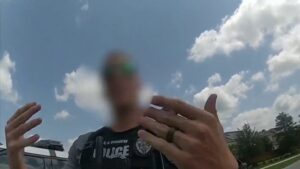The impact of Mexican cartels on U.S. law enforcement: Understanding the threat
The cartels’ illicit activities in the United States are often inconspicuous. The subtlety creates a disconnect between American streets and the cartels, sometimes making it challenging for even the most experienced officer, deputy, or agent to detect cartel influence. Recognizing the presence of cartel activity on American streets can facilitate the identification of their tactical shifts, which include using social media platforms for recruitment and collaborating with American gangs to broaden their reach.
In 2020, the Drug Enforcement Administration (DEA) released its National Drug Threat Assessment, which includes a map (see Figure 1) showing the regions in the United States where Mexican cartels had established influence. Local gangs work with the cartels to distribute substances such as methamphetamine, cocaine, heroin, and fentanyl products.
There are several Mexican cartels, but the two dominant cartels responsible for inundating American streets are the Sinaloa Cartel and the Cártel Jalisco Nuevo Generación (CJNG). The Sinaloa Cartel, widely recognized as the most extensive criminal organization in Mexico, comprises of a network of smaller organizations. Some analysts warn that the Sinaloa Cartel remains powerful due to its international dominance, its infiltration of the upper echelons of the Mexican government, and its adaptable networked alliance structure, that by some estimates, extends to 50 countries.
Originally dubbed the Zeta Killers, the CJNG first emerged in 2011 with a grisly display of 35 corpses believed to be members of Los Zetas. Their acts of violence have only escalated since then. The CJNG controls several Mexican ports, granting them access to essential precursor chemicals imported from China and other Latin American countries. CJNG has taken advantage of the high demand for Mexican methamphetamine, heroin, and fentanyl in the United States to aggressively expand its operations.
Drug trafficking, money laundering in the United States
The influence of Mexican cartels on America’s streets is an increasingly important issue for American law enforcement officers and leaders. From the distribution of drugs to the perpetration of violence, these cartels are impacting the safety of communities across the United States.
In April 2023 the U.S. Attorney’s Office reported that a two-year investigation by the FBI and DEA resulted in the indictment of 12 Sinaloa Cartel members implicated in laundering over $16 million. Investigators also rescued two victims of an extortion plot orchestrated by the cartel. The cartel activities and subsequent investigation occurred in several locations across the United States, including Chicago, Omaha, Boston, New York City, Baltimore, Charlotte, Philadelphia, Las Vegas, and San Diego.
Cartel activities are not confined to border states
Cartel activities are not confined to the southern border states of California, Arizona, New Mexico and Texas. Even small towns in the least populated states are impacted. In 2019, a major multi-agency investigation was launched into a drug-trafficking network that connected Montana residents to members of Mexico’s Sinaloa Cartel. The investigation resulted in the conviction of 22 individuals on federal charges. The organization trafficked approximately 2,043 pounds of methamphetamine, 722,000 fentanyl-laced pills and heroin to Butte County, Montana for distribution.
According to an ABC News report, the Montana Attorney General, Austin Knudsen, attributes the surge in crime to the influence of Mexican cartels, citing intelligence reporting that links two Mexican cartels to towns in Montana. Knudsen stated, “We have specific intelligence that primarily two drug cartels based out of Mexico are operating here in Montana on a very large scale.”
The scourge of cartel drugs on U.S. streets
The scourge of cartel drugs on the streets of the United States, from large cities to small towns, impact police resources.
Combatting cartel activities
Cartel recruitment efforts are ramping up in the United States as they recruit members of notoriously violent American gangs like the Bloods, the Crips and the Aryan Brotherhood to work both sides of the United States/Mexico border. These links have been identified as operational in Texas and California, with their influence felt across the United States.
Law enforcement agencies face the daunting task of allocating substantial time and resources to combatting cartel activities. This involves conducting thorough investigations, executing arrests, and confiscating illicit assets. The resource-intensive nature of countering crimes resulting from cartel operations can place a strain on police departments, hampering their ability to effectively address other criminal activities within their communities.
Resource strain on police departments
In addition to the strain on resources, the criminal elements undermine police efforts to build trust with their communities. The nature of the business conducted by drug cartels and other organized crime groups can foster a culture of fear and mistrust in communities, making it difficult for law enforcement to build relationships with the people they serve. This can lead to a breakdown in communication between law enforcement and the community.
Undermining community trust
Drug cartels present a formidable threat to both law enforcement and communities in the United States, particularly in terms of drug trafficking and violence. Their operations not only endanger the lives of law enforcement officials but also burden police resources, erode community trust in the police and potentially foster instances of police corruption. Furthermore, the proliferation of drugs in specific regions has resulted in a surge in addiction rates, overdoses and drug-related criminal activity.
Conclusion
Addressing the multifaceted threat
Addressing the impact of drug cartels on law enforcement requires a multifaceted approach that involves identifying and disrupting evolving tactics used by cartels and their affiliated gangs, addressing the root causes of drug trafficking, bolstering law enforcement efforts, and promoting policies that prioritize community safety and well-being.
Intelligence sharing and collaboration
To this end, intelligence collection, sharing and collaboration with other state, local and federal agencies will help curb cartel influence in jurisdictions. State fusion centers allow for all law enforcement agencies to collaborate, de-conflict, and share resources. A unified effort to combat cartel influence in the United States is an ongoing and long-term effort.
FAQs
Q: How do Mexican cartels impact U.S. communities?
A: Mexican cartels pose threats to U.S. communities through drug trafficking, violence, exploiting vulnerable populations, and undermining trust between law enforcement and the public. Their operations burden local resources and foster environments of fear.
Q: What illegal activities are Mexican cartels involved in?
A: Mexican cartels engage in drug trafficking, human trafficking, weapons trafficking, money laundering, extortion, kidnapping, and murder. They smuggle drugs like cocaine, heroin, fentanyl and methamphetamine into the U.S.
Q: How do cartels infiltrate U.S. institutions?
A: Cartels infiltrate U.S. institutions by bribing officials, placing cartel members in positions of power, and utilizing shell companies to hide illicit financial activities. This facilitates their ability to operate with impunity.
Q: What can local police departments do to combat Mexican cartels?
A: Local police can prioritize investigations into cartel activities, increase collaboration with other agencies, bolster community policing efforts, and advocate for policies that provide more resources to combat organized crime.
Q: Why is a collaborative approach necessary to address this issue?
A: Given the expansive reach and influence of Mexican cartels across jurisdictions, a collaborative approach involving local, state and federal agencies is critical to collecting intelligence, disrupting operations, and addressing root causes. No single agency can effectively combat this alone.




